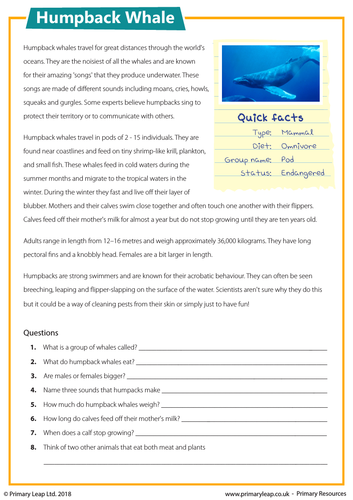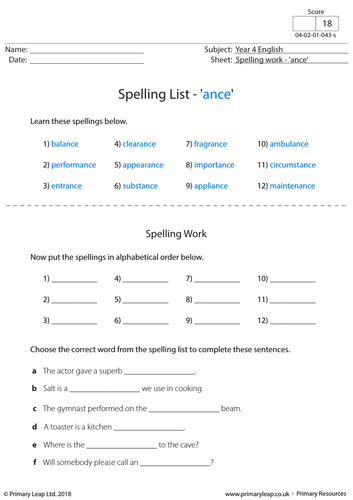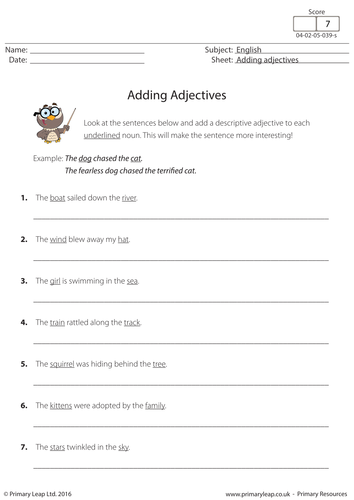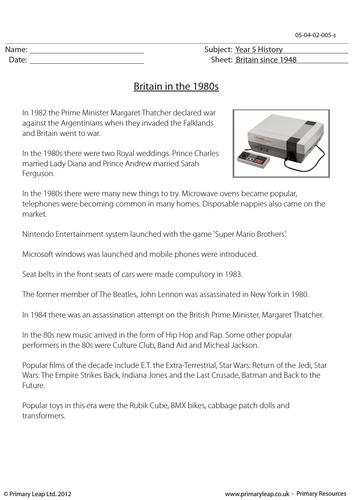512Uploads
453k+Views
210k+Downloads
All resources

KS2 Reading Comprehension - Charles Dickens
Charles Dickens was born on 7th February in 1812. Celebrate his birthday with this reading comprehension including some interesting facts and information about the famous writer. Students read through the text and answer the questions. This resource was created by Lauren Savage @ Primary Leap

Making Inferences from Pictures 3
Inferences are what we figure out based on an experience. Helping students understand when information is implied, or not directly stated, will improve their skill in drawing conclusions and making inferences which is an essential skill in reading comprehension. Students are asked to look at the picture and then answer the questions.
Find more resources at Primary Leap

KS2 English worksheet: Phonics - 'ire' and 'ear' words
This English worksheet asks students to complete the sentences by choosing the correct word from the word bank. This resource focuses on the phonics ‘ire’ and ‘ear’.
This worksheet was created by Lauren Savage @ Primary Leap

KS2 Reading Comprehension - Humpback Whale
This year 5 English worksheet includes a short passage with facts about humpback whales and questions to follow.
This worksheet was created by Primary Leap

Match the Contractions - English Resource
A contraction is a word made by shortening and combining two words. Words like can’t (can + not) and don’t (do + not) are contractions. Students draw a line to match the contractions.
Additional worksheets, lesson plans, and interactive activities are available on Primary Leap.

Common Exception Words 2
Common exception words are ‘tricky words’ to read. Some exception words are used very frequently, which is why children should start reading and writing them at an early age. This English resource helps students practise reading and writing common exception words. They are asked to read the word and use it in a sentence.
Find more resources at Primary Leap

Relative clauses
Relative clauses are used to connect sentences. We use relative clauses to give additional information about something without starting a new sentence. The most common relative pronouns are: who, whom, whose, which and that. This English resource asks students to choose the best relative pronoun to complete the sentences.
This worksheet was created by Lauren Savage

KS2 English Worksheet - Spellings 'ance'
A KS2 English resource including a list of 12 words ending with ‘ance’ for students to learn. There are exercises including putting the words in alphabetical order and choosing the correct word from the spelling list to complete the sentences.
This resource was created by Primary Leap

Reading comprehension - Christmas in France
This worksheet was created by Lauren Savage @ Primary Leap
What happens in France at Christmas? Students are asked to read the text and answer the study questions.

Christmas Spellings 2
This worksheet was created by Lauren Savage @ Primary Leap
This Christmas themed worksheet includes 12 spellings for children to learn. Children must also put the spellings in alphabetical order and fill in the missing words to complete the Christmas carols.

KS2 English Worksheet - Hidden Words
This worksheet was created by Lauren Savage @ Primary Leap
Students use a word of two letters to fill the gap in each of the sentences.

Phonics - ow and oa
This worksheet was created by Lauren Savage @ Primary Leap
Learning phonics - a KS2 English worksheet that focuses on ‘ow’ and ‘oa’. Children must fill in the missing letters and sort the words correctly. This resource is great for reading and spelling.

Type of sentences: statement, command, question and exclamation
This worksheet was created by Primary Leap
A statement gives us information
e.g. the sky is blue.
A command tells us to do something
e.g. go and brush your teeth.
A question asks us something
e.g. how old are you?
An exclamation shows us that someone feels strongly about something
e.g. ouch!
Students read the sentences and write statement, command, question or exclamation next to each one. They also need to add the correct punctuation at the end of each sentence (., ?, !)

Auxiliary verbs
Auxiliary verbs, or helping verbs, add meaning to the main verb of the sentence. This literacy resource asks students to complete sentences by adding auxiliary verbs.
This worksheet was created by Lauren Savage

Adding Adjectives (1)
Students are asked to add a descriptive adjective to each underlined noun. This will make the sentences more interesting and is good practice for story writing.

KS2 History Resource - Britain in the 1980s
KS2 History Resource - Britain since 1948. This worksheet includes some interesting facts and events in the 1980s. Students read the text and answer the study questions.
This worksheet was created by Primary Leap

History Resource - Cloze Activity: Remembrance Day Facts
This worksheet was created by Primary Leap
When is Remembrance Day held? Who wrote the poem ‘In Flanders Fields’? This history resource asks students to read the facts about Remembrance Day and fill in the missing words. There is a word bank to help them.
Additional worksheets, lesson plans, and interactive activities are available on Primary Leap.

Science Worksheet - Magnets Vocabulary
This worksheet was created by Primary Leap
This science worksheet shows a list of words and their definitions that are all related to magnets. Students are asked to match the words on the left with their correct meaning on the right.

Research Activity - All Saints' Day
All Saints’ Day, also known as All Hallows, is celebrated on 1st November by the Catholic Church, in honour of all the saints, known and unknown. Students are asked to choose one of the four patron saints mentioned in the worksheet and find out some important information about them. They are asked to include when their special day is, if they have a symbol and why people remember that day.

Verb prefixes - de and re
A prefix is a group of letters added before a word to alter its meaning. The prefix ‘de’ is used to reverse the verb’s actions. It can also mean ‘down’ such as in the words decrease or decline. The prefix ‘re’ means to do again. This English resource asks students to choose the correct word to complete the sentence.
This worksheet was created by Lauren Savage




















